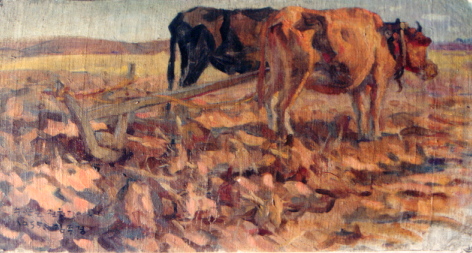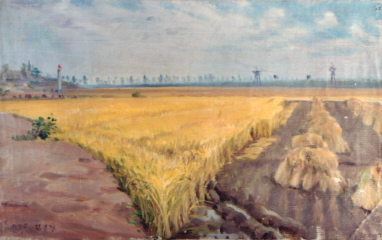| Kim
Chu-gyŏng (1902-1981) A native of North Ch'ungch'ŏng Province, Kim graduated from the Tōkyō School of Fine Arts in 1928, and upon returning to Korea became one of the country's most prominent oil painters. Until the late 1930s, Kim experimented successfully with a variety of different styles. However, as illustrated by the images and an illustrated essay in a 1938 book published with his close friend, painter O Chi-ho, towards the end of the colonial period he found his own style in a special kind of Post-Impressionist mode: landscapes depicting the sky and clouds with heavy object colors, and flowers, trees, people in strong bright greens and/or violet. Some of the stylistic elements typical for Kim's work survived  the post-Liberation era—he favored desolate landscapes that often
seem almost geometrically calculated, and used a
the post-Liberation era—he favored desolate landscapes that often
seem almost geometrically calculated, and used a  reduced palette of colors. While his works done in the North still show
the use of a limited number of colors, these later works are done in a
more realistic coloring scheme (e.g. the sky would be azure blue and the
rice field at harvest time in yellow and not violet). We see little experimentation
and few differences in style between his late 1940s works and those of
the 1970s. In October of 1946, Kim left for the North, and in the following
year was elected to the drafting committee of the first DPRK constitution.
He was also responsible for the design of the North Korean
national flag and the national emblem. In the same year he helped establish
P'yŏngyang Art School and became its first director. When the school
was upgraded to university status, Kim became a professor of oil painting,
and in his later years worked for the Central Committee of the Korean
Artists Union and became involved in the production of children's art
books. After the Korean War Kim seems to have lost much of his early influence
and power.
reduced palette of colors. While his works done in the North still show
the use of a limited number of colors, these later works are done in a
more realistic coloring scheme (e.g. the sky would be azure blue and the
rice field at harvest time in yellow and not violet). We see little experimentation
and few differences in style between his late 1940s works and those of
the 1970s. In October of 1946, Kim left for the North, and in the following
year was elected to the drafting committee of the first DPRK constitution.
He was also responsible for the design of the North Korean
national flag and the national emblem. In the same year he helped establish
P'yŏngyang Art School and became its first director. When the school
was upgraded to university status, Kim became a professor of oil painting,
and in his later years worked for the Central Committee of the Korean
Artists Union and became involved in the production of children's art
books. After the Korean War Kim seems to have lost much of his early influence
and power.
|

